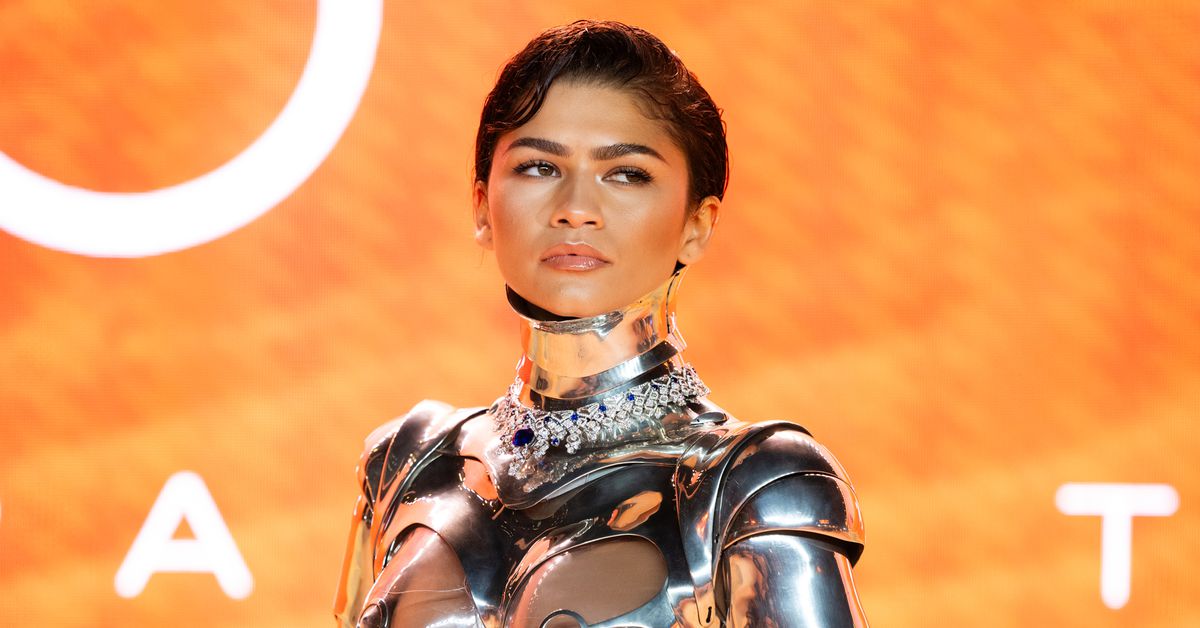The Bene Gesserit are masters of intrigue in the Dune novels, executing millennia-long schemes that involve manipulating the Emperor and Great Houses, seeding prophecies, and breeding a chosen one. Writer-director Denis Villeneuve shows off their mysterious power and the scope of their influence in his movie adaptations of the Dune books, but author Frank Herbert spent a lot more time exploring and explaining how the organization actually works — particularly in his last two novels, which are unlikely to ever be adapted for the screen.
As weird as the ancient society is in Villeneuve’s movies, though, they’re much weirder in the books, in ways that audiences who only know Dune from these recent movies might find hard to believe. Here’s how the Bene Gesserit in the movies compare to the much wilder version in the books.
[Ed. note: This story contains spoilers for Frank Herbert’s Dune novels and Denis Villeneuve’s Dune and Dune: Part Two.]
Fremen orgies, psychic voyeurism, and Lady Jessica’s baby
:no_upscale()/cdn.vox-cdn.com/uploads/chorus_asset/file/25317625/rev_1_DUN2_44606rv2_High_Res_JPEG.jpeg)
To secure a place for Paul (Timothée Chalamet) and herself among the Fremen of Sietch Tabr, Lady Jessica (Rebecca Ferguson) agrees to replace their dying Reverend Mother by undergoing a rite that involves drinking the Water of Life, a concentrated form of spice created by drowning a baby sandworm. While the details of the ritual vary by society, this is the same process used to elevate all Bene Gesserit sisters into Reverend Mothers, giving them access to the memories of their predecessor in the role and their own ancestors by unlocking their genetic memory.
Bene Gesserit are trained to resist poison in part to allow them to undergo this process. In the book Dune, Jessica also uses her abilities to molecularly break down the Water of Life and create a less potent version of it that Paul and the rest of the sietch drink while she gets acquainted with the old Reverend Mother, who now shares her body. The drug creates a psychic connection between members of the tribe, prompting an orgy that the film skips in favor of focusing on Chani and Paul first getting together in a more intimate moment.
While Jessica survives the rite, there’s a big complication in that she’s pregnant. The Water of Life would have killed a male fetus, but since Jessica’s having a girl, it also transforms the unborn child into a Reverend Mother. The two of them spend the rest of the movie psychically connected and plotting to keep Paul safe.
One of the biggest departures from the source material in Villeneuve’s adaptation involves that kid, who will be named Alia. Villeneuve condenses Paul’s time learning the ways of the Fremen to just a few months, when in the books, it takes years. During that time, Jessica has her extremely weird baby. While still a child, Alia becomes a leader of a Fremen squad of women, children, and old men who are so fearsome, they force the Emperor’s dreaded Sardaukar troops to retreat.
Alia allows herself to be captured so she’ll be brought to the Emperor and Baron Harkonnen, where she really freaks out the Emperor’s Reverend Mother advisor by getting inside her head — an ability she explains is not actually telepathy, but the power to connect with other Reverend Mothers through ancestral memory. When the Fremen attack, Alia is the one who kills Baron Harkonnen by stabbing him with a gom jabbar, the poison needle Bene Gesserit use in their torture tests.
While David Lynch used this scene in his 1984 Dune adaptation, it’s understandable that Villeneuve wanted to give the big moment of vengeance to Paul instead. If Villeneuve gets to make the Dune Messiah adaptation he wants, though, Alia will be a major character played by Anya Taylor-Joy, who makes a very brief appearance in Dune: Part Two, guiding Paul through his own version of the Water of Life trial.
In Herbert’s second book, Dune Messiah, Alia continues to protect Paul and his family from would-be usurpers while also falling in love with a clone of Duncan Idaho, the character played by Jason Momoa in Villeneuve’s first Dune. Duncan is cloned many, many times throughout Dune’s timeline, making him the only character to appear in all of Herbert’s books.
Alia’s character gets even weirder in Herbert’s third book, Children of Dune, which Villeneuve understandably has no interest in adapting. The problem with absorbing so many memories while still a fetus is that Alia didn’t have an established personality of her own, which is why the Bene Gesserit call her an abomination. All these minds start fighting for control of her body — including her grandfather and murder victim, Baron Harkonnen. He offers to help her keep the other personalities in check, and to give her advice she can use to pursue her own ambitions. All he asks for in exchange is access to her senses when she’s having sex. However, the Baron quickly starts exerting more and more influence over her, until she kills herself at the urging of Paul’s son, Leto II.
What does Lady Margot Fenring do to Feyd-Rautha?
:no_upscale()/cdn.vox-cdn.com/uploads/chorus_asset/file/25317630/rev_1_DUN2_06002r_High_Res_JPEG.jpeg)
The Bene Gesserit have spent 90 generations on a selective breeding project meant to produce the Kwisatz Haderach, a man who can acquire the powers of a Reverend Mother. Both Paul Atreides and his cousin Feyd-Rautha Harkonnen (Austin Butler) are products of this scheme — Paul was actually meant to be a girl who would breed with Feyd-Rautha. But after the Harkonnens supposedly kill all the Atreides on Arrakis, the Bene Gesserit Lady Margot Fenring (Léa Seydoux) is deployed to ensure that at least part of the experiment survives.
In the book, we just see Margot watch Feyd-Rautha show off in the gladiatorial arena, then explain her plans. Villeneuve actually shows her addling the future Baron Harkonnen’s mind, seducing him and subjecting him to the gom jabbar test. She returns from her mission pregnant with a girl and convinced that she can control Feyd-Rautha with sex.
This becomes a moot point, since Paul kills Feyd-Rautha soon after that. But Herbert’s last two Dune books spend a ton of time explaining exactly what that control means. These books are unlikely to be adapted, considering that they’re set thousands of years after the events of Dune and follow the events of God Emperor of Dune, which would make a terrible movie. But that’s a shame, considering how wild they are, filled with religious conflict, shapeshifting spies, and lots of descriptions of the power of mutual orgasm.
The far, freaky future of Dune sex
:no_upscale()/cdn.vox-cdn.com/uploads/chorus_asset/file/22937062/rev_1_DU_21469_Sr_High_Res_JPEG.jpeg)
One of the central characters of these books is Lucilla, a Bene Gesserit Imprinter specially trained to use sex to power their breeding program and otherwise manipulate men. At one point in Herbert’s fifth novel, Heretics of Dune, she explains the extent of her powers, which include mastering the 300 steps of orgasmic amplification and the 205 sexual positions, along with arousing the 51 excitation points.
The Honored Matres, an offshoot of Bene Gesserit, don’t use spice to access genetic memory, but instead focus more on mastering physical techniques that make them extremely formidable in combat and in bed. They use sex to enslave entire planets until the Bene Gesserit team up with the geneticists of the Tleilaxu to create a weapon against them: a clone of Duncan Idaho Lucilla trained to be irresistible to women. When the Honored Matre Murbella tries to imprint Duncan, it triggers genetic programming built into him by the Tleilaxu that allows him to access the memories of all the previous Duncans and become just as good as sex as Murbella.
Their sex is so good that she and Duncan become addicted to each other. This eventually leads Murbella to join the Bene Gesserit and unite the two factions. It’s a shame that we’ll almost assuredly never get to see Jason Momoa thrusting his way into galactic peace. But if anyone wanted to make a pornographic space opera, they could do a lot worse than adapting Heretics of Dune and Chapterhouse: Dune.







